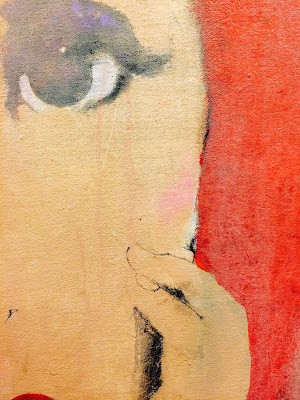The Boston Post Road through Guilford, Madison, and Clinton,
Connecticut is filled with elegant 18th- and 19th-century houses, many with private beaches; the two-mile long Hammonasset
State Beach is the best point of public access. But for sightings of marshes
and birds, New England houses, and a beautiful village green, you must consider
visiting the Guilford Green and walking down the lane to the Greene Art
Gallery. You might know Guilford
from the arts and crafts fair, held on the green each summer (this year, its 58th,
July 17-19, 2015). Whether or not you visit the fair, come
and see the works at this gallery, year round; the range and quality of work is
exciting to see.
Richard Greene founded the gallery in 1977, and his widow,
Kathryn, continues to engage a fine and varied group of artists. And she is happy to talk about the art
on display, or to invite visitors to wander through quietly and take in the
artists’ work. The gallery is located in an updated, bright and (recently
expanded) barn, and the art spills out to the quiet side lawn with several
sculptures that move in the breeze.
A west-coast artist, Matt O’Callaghan, presents photographs that are printed on
metallic paper. All we see, initially, is a clear
surfer’s wave:
But then, we step closer, and we see the reason for the photograph’s
title, “South Shack, San Diego.”
Houses bathed in yellow and white light cling to the
Southern California cliffs, palm trees waving overhead: we can SEE these through
the curve of the wave. Yes, it’s a
real photograph, the moment of time on camera catching the glimpse in a way the
eye can’t quite do.
Further playing with the ways to “re-present,” Clio Newton’s
portraits (along with an amazing still life, pewter arranged over shelves) are
featured this month in the gallery extension. Her work seems, from a distance,
to be photorealist, but as the viewer comes closer to the work, the brushwork
is fully evident and the details of the painting lean towards the abstract.
Here is a charcoal drawing, “Girl in Chair,” by Newton which might illustrate
this combination of a work that is figurative-from-afar, yet, as we study the
effects, we can see traces of the artist’s skilled hand:
Newton’s figures contrast with those painted by another
gallery artist, Dolph Lemoult. His
works play more fully on the boundary, leaping between abstract and representational.
These portraits are immersed, in context, in a kind of foreground-background
dance. The artist (a former ad man) is not trying to give us “real” human
faces; he has chosen aspects of “face-ness” to give us. Here is “American Mezzotint: Bad Girls”:
As you can see from the detail, the lines trail off, into
the imagination. He is working that (unsee-able) line between what we know and what
we cannot see. My favorite work of his at the gallery is “American Mezzotint:
Silence.”
There is something haunting about these figures, and about
their very specific enclosure. Is that a city back to the left? Are these
Depression-age babies? Is the face in close-up softening into layers of
personality and experience? or into paint? as we look... It’s really an
extraordinary grouping. How
abstract can a work become before it loses its representational “edge”?
I think this is a rewarding direction to head into... Go.
See. This gallery is a solid presence.










No comments:
Post a Comment